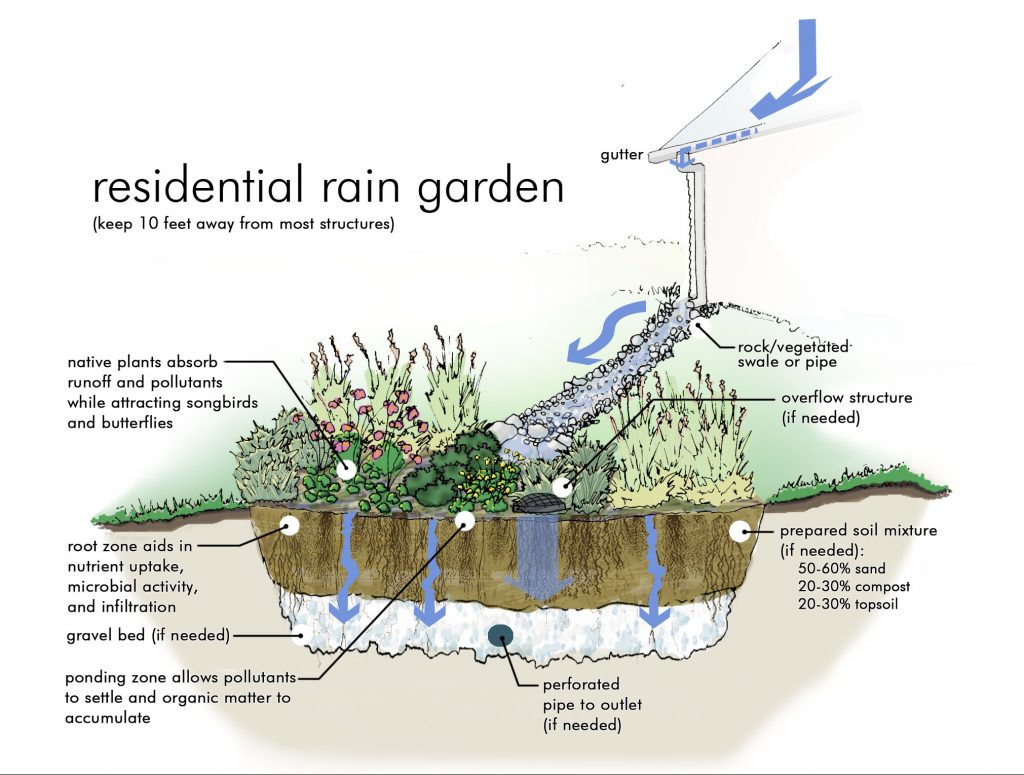Using Native Plants
There are Different Ways to Protect Water with Native Plants
You can use native plants anywhere on your property and capture some of their benefits. This includes foundation plantings and other typical landscape beds. Rain gardens and shoreline plantings, however, are the most impactful.
Rain Gardens
Rain gardens are shallow depressions in a yard that are stocked with native plants and designed to capture and infiltrate stormwater, keeping it from running off the property and polluting our waterways. Often, a structure’s downspouts will be directed into the depression, though they can also catch water from swales or other conveyances. The native plants used in rain gardens tolerate periods of inundation (high water or consistently wet soil) and drought, and their deep roots help filter water as it percolates down into the soil. If designed and built correctly, rain gardens do not hold water long enough to become attractive breeding grounds for mosquitos.

Check out this guide from the Toledo-Lucas County Rain Garden Initiative to learn how to install and maintain a rain garden on your property. There are links to sample planting plans on this page, and a list of native plant suppliers here.
County Soil and Water Conservation Districts are often great resources for technical assistance. Some may also have funding to help with the installation costs.
Below are some examples of planting plans with plant lists for rain gardens with variations depending on the style of rain garden you desire.
Rain Garden – Attracting Birds & Butterflies
Rain Garden – Low Diversity of Plants
Rain Garden – Short Statured Plants
Rain Garden – Plants that Tolerate Partial Shade
Tips and Tricks
Native plants might be a different aesthetic than we’ve become accustomed to. They aren’t your grandmother’s roses! There are a few tricks, however, to taming the ‘wild’ look if you’re hoping to baby step your way into a landscape that does more than just hide the house’s foundation.
Create an Edge
You can use a native grass like Prairie Dropseed to create a border for your planting. You could even use a standard boxwood shrub if a more conservative approach is appropriate. Either way, a clear edge helps convey a sense of purpose.
Create Some Rhythm
Place plants in odd-numbered groups (3-5-7, etc.) and repeating masses. In other words, five purple coneflowers on the left, seven more in the center, and another five on the right. Do this with multiple species to create a sense of rhythm and order through the landscape. You can still use single plants or smaller individual groupings for highlights without spoiling the effect.
Keep It Flowering
Plant lists like this one show each species’ flowering time. Select a range of species that cover the whole growing season. Not only does this provide food and habitat for more wildlife, but it’s hard to complain when there are flowers in the landscaping!
Right Plant, Right Place
If you are trying to keep a more controlled look with your native plants, know which ones are tall and which are short. The tall ones should go in the back of your bed or, if the bed doesn’t have a backside, where they won’t hide smaller plants or fall over the edge. If you’re planting a rain garden, be sure to know which plants tolerate wet feet the best—these go in the bottom of the basin.
Certify Your Wildlife Habitat
Once you have installed native plants in your landscape, you might like to get some recognition for the work you’re doing for our environment. The National Wildlife Federation offers a certification program for backyards, neighborhoods, businesses, schoolyards, and just about any other property. Once a property is certified, the landowner has the option to install a nice sign identifying the area as wildlife-friendly. Let your neighbors see how important your yard is to wildlife!